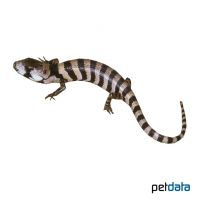Pink-toungued Skink (Cyclodomorphus gerrardii)
| Pink-toungued Skink Cyclodomorphus gerrardii | |
|---|---|
| Name | Pink-toungued Skink |
| Name Lat. | Cyclodomorphus gerrardii |
| Synonym | Hemisphaeriodon gerrardii |
| Family | Skinks |
| Family lat. | Scincidae |
| Order | Scaled Reptiles |
| Order lat. | Squamata |
| Origin | Australia |
| Habitat | Forests |
| Diet | Snails, worms |
| Humidity | 60-90 % |
| Behavior | Peaceful |
| Keeping | Pair |
| Care Level | Difficult |
| Reproduction | Ovoviviparous |
| Housing | Humid terrarium |
| Life Span | 10 years |
| Protection | No |
| Metric Units | |
| Size | 35 cm |
| Temperature | 20-28 °C |
| Temperature Local | 40 °C |
| Housing Size | 80 x 60 x 120 cm |
| US Units | |
| Size | 14" |
| Temperature | 68-82 °F |
| Temperature Local | 104 °F |
| Housing Size | 30" x 25" x 45" |
Distribution and habitat
The range of the snail skinks is in eastern Australia, from Cape York in the north to Sydney in the south. The good climbers live in the coastal moist forests and open tree landscapes, where they usually hide under foliage but also in tree hollows.
Maintenance
Minimum dimensions for the terrarium, according to the size and number of animals
| 1-2 animals | 4KRL x 3KRL x 6KRL or 4KRL x 4KRL x 5KRL (L x W x H) |
Head-torso length (KRL) is measured on the largest animal. For each additional animal, increase the footprint by 15%. A terrarium of e.g. 80 x 60 x 120 cm is recommended, which should be placed in a quiet and vibration-free place.
They need a humid terrarium with high climbing branches and stone superstructures, a planting of Pandanus and sturdy Ficus as additional climbing and hiding places as well as structured back and side walls (e.g. cork covering) and a small water bowl. Terrarium humus or a soil-peat mixture covered with some foliage and bark mulch is suitable as substrate. A large part of the substrate should be kept moist at all times. At least once a day the inside of the terrarium should be finely sprayed with water (humidity). A rain or mist system is ideal.
| Temp. day: 20-28 °C | Temp. night: 18-22 °C | Temp. local: 40 °C | Humidity: 60-90 % |
Thermostatically controlled floor heating is recommended. Lighting duration must be 12-14 hrs, depending on the season. They need sunny places with radiant heat and daily UV irradiation.
Diet
In nature they feed mainly on snails and worms. The food supply consists of worms and insects (crickets, house crickets, etc.), but mainly of collected or bred nudibranchs and slugs, although frozen slugs are also accepted. These must be thawed at least half an hour before feeding. Commercially available special food for insectivorous reptiles can be offered as a supplement and replacement food. Regular addition of minerals and vitamins is important. Young animals should be offered food daily, adults 4-5 times a week (approx. 6 snails per feeding). Drinking water must always be available
A regular and varied diet promotes health and prevents deficiency symptoms.
Reproduction and breeding
The sexes are difficult to distinguish. Males have a slightly broader head and a thickened tail root.
They are viviparous (ovoviviparous). After a gestation period of about 5 months, an average of 25 young are born, which already eat snails of the appropriate size.
Life expectancy can be 10 years.
Important
Keeping them in pairs is recommended
They need hiding places and according to their need for warmth sunny places, such as climbing branches or stones irradiated by a spot
A hibernation of about 2 months at a temperature of 10-15 °C and a lighting duration of about 8 hours is recommended
With fruit and honey water as food for the feeders, their quality can be upgraded.
The terrarium must have good ventilation without drafts and meet the species specific needs. Measuring devices such as thermometers, hygrometers, etc. are necessary. The lighting has to correspond to the species-specific day-night rhythm and has to be placed in such a way that the animals cannot injure themselves. The terrarium should be locked in such a way that neither unauthorized persons can open it nor the animals can escape. Contamination must be removed regularly
Further literature can be found in your pet store.
References
Text: petdata; Image: petdata
Source: BMELV Deutschland (1997): Mindestanforderungen an die Haltung von Reptilien; ENGELMANN (2006): Zootierhaltung - Tiere in menschlicher Obhut: Reptilien und Amphibien, Harri Deutsch Verlag
- Gemäß § 21 Abs. 5 Tierschutzgesetz idgF
